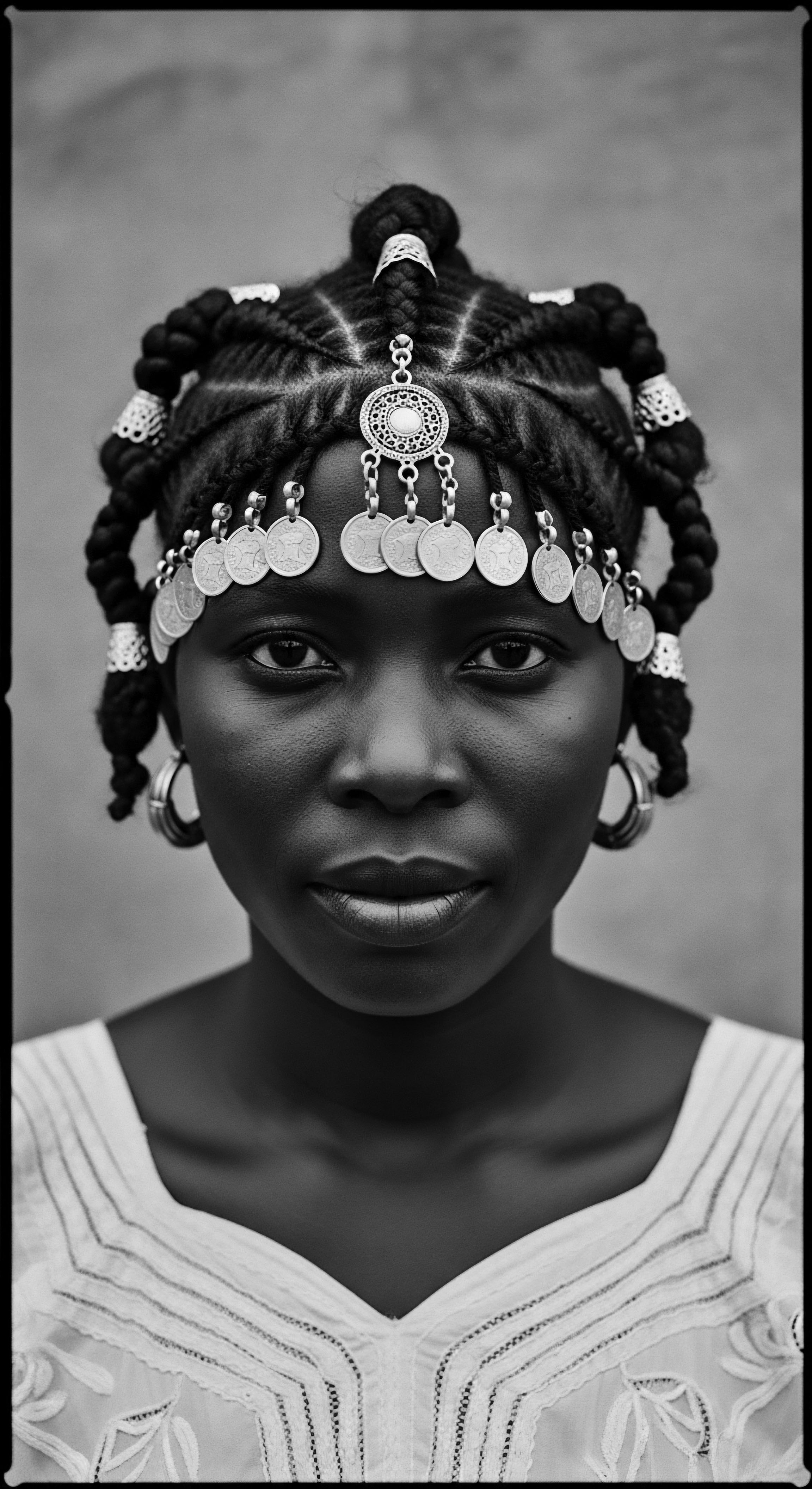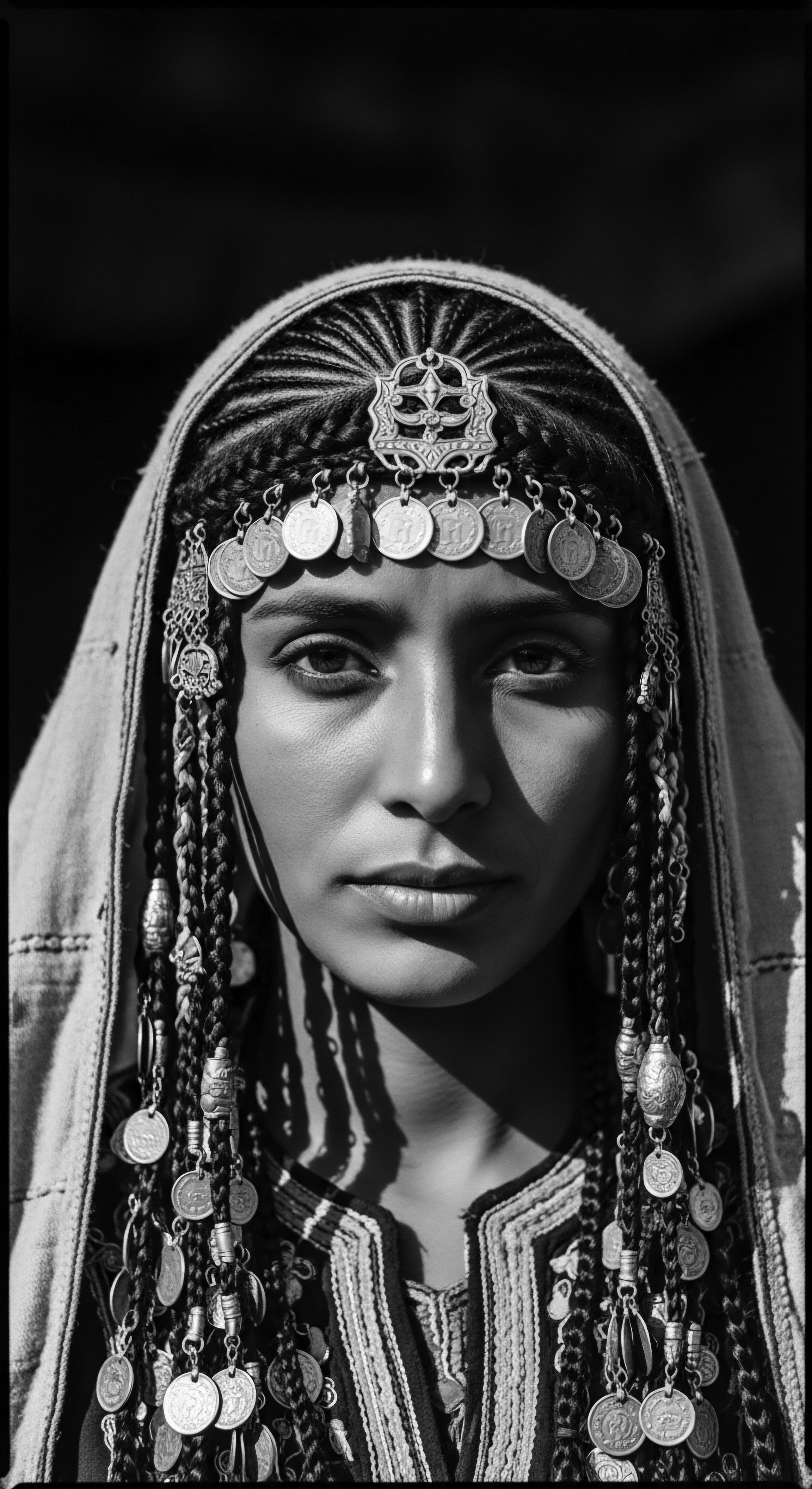
Fundamentals
The concept of cold-pressed oil, at its most elemental level, describes a method of oil extraction where minimal heat is applied during the process. This approach relies on mechanical pressure to coax the liquid gold from seeds, nuts, or fruits. Unlike conventional methods that often employ high temperatures or chemical solvents, cold pressing ensures the raw material’s inherent properties remain preserved.
It is a gentle art, maintaining the vitality and integrity of the oil, allowing for the retention of beneficial compounds such as vitamins, antioxidants, and essential fatty acids. This preservation of natural elements distinguishes cold-pressed oils as vital resources, especially for those who honor ingredient purity.
From an ancestral perspective, the pursuit of oil extraction has always been about drawing out the nourishing essence from nature’s bounty. While the term “cold-pressed” might appear modern, the wisdom behind its principles dates back centuries. Early communities, particularly those in Africa and across the diaspora, intuitively understood the value of gentleness in preparation. They sought to extract oils in ways that maintained their potency, whether through grinding, pounding, or kneading, minimizing any harsh treatments that would diminish the plant’s life force.

The Gentle Extraction Process
Understanding cold-pressed oil begins with its creation. Seeds or fruits are first cleaned, then introduced into a mechanical press. This machine exerts immense pressure, squeezing the oil from the raw material. The friction generated during this mechanical action produces some heat, but the temperature is strictly controlled, generally remaining below 120°F (49°C).
This careful temperature regulation prevents the degradation of delicate nutrients, ensuring the oil retains its natural color, aroma, and flavor. Following the pressing, the oil is often left to settle, allowing any solid particles to decant, before being filtered to achieve clarity without chemical intervention.
- Seed Preparation ❉ Raw materials are meticulously cleaned to remove impurities, ensuring the final oil is of the highest quality.
- Mechanical Pressing ❉ A screw or hydraulic press applies sustained pressure, separating the oil from the solid plant matter.
- Temperature Control ❉ Throughout extraction, temperatures are closely monitored to prevent excessive heat buildup, safeguarding the oil’s nutritional profile.
- Natural Filtration ❉ After pressing, the oil undergoes a natural sedimentation process, followed by mechanical filtration, to remove any remaining particulate matter without chemical aids.

Initial Benefits for Hair and Skin
The advantages of cold-pressed oils for hair and skin are readily apparent even at a fundamental level. Their rich concentration of vitamins, minerals, and antioxidants means they offer a potent source of nourishment. These natural elements work to hydrate, protect, and revitalize, addressing common concerns like dryness and breakage. The absence of harsh chemicals in their processing also means they are pure and gentle, making them suitable for sensitive scalps and skin, aligning with a desire for clean, natural wellness routines that harken back to traditions of purity.
Cold-pressed oil emerges as a pure extraction, honoring ancient wisdom that prioritizes gentle methods to preserve the natural vitality of botanical gifts for holistic wellbeing.
The integrity of these oils is paramount. When heat is avoided, the complex fatty acid profiles, crucial for hair health, remain intact. This translates to an oil that can deeply penetrate the hair shaft, offering moisture and strengthening the strand from within. For textured hair, which often requires consistent moisture, the deep hydration provided by cold-pressed oils becomes a cornerstone of care, supporting natural resilience.

Intermediate
Expanding upon its foundational meaning, cold-pressed oil represents a deliberate choice in the world of botanical extracts, a method that respects the innate composition of the source material. This approach goes beyond mere extraction; it signifies a commitment to preserving the complete biochemical profile of the plant. The rigorous adherence to low temperatures during processing means that sensitive compounds—such as polyunsaturated fatty acids, fat-soluble vitamins (like Vitamin E), and various phytonutrients—remain stable and active. This distinguishes cold-pressed oils significantly from their refined counterparts, which often undergo high-heat treatments, chemical deodorization, and bleaching, stripping away much of their nutritional value and altering their molecular structure.
Historically, communities relied on intuitive knowledge to achieve what modern science now validates as beneficial. The techniques employed by our ancestors, though lacking precise temperature gauges, inherently favored gentler methods that resembled the cold-pressing principle. Consider the meticulous work of hand-pounding seeds or grinding nuts with stone mills; these actions generated minimal frictional heat, ensuring the integrity of the resulting oil. This ancestral understanding forms a continuous thread with contemporary appreciation for cold-pressed oils, highlighting a timeless quest for potent, natural remedies.

The Distinctive Chemistry of Cold-Pressed Oils
The chemical composition of cold-pressed oils stands as a testament to their superior processing. When seeds are pressed without excessive heat, the delicate fatty acids maintain their cis configuration, which is the natural and most bioavailable form. High heat, conversely, can lead to the formation of trans fats, which offer little nutritional benefit and can even be detrimental. Furthermore, the antioxidants present in the original plant, including tocopherols and polyphenols, are largely retained.
These compounds serve as natural preservatives for the oil itself, extending its shelf life, and also provide protective benefits when applied to hair and skin, shielding against environmental stressors. This preservation of vital compounds enhances the oil’s efficacy.
- Fatty Acid Preservation ❉ Cold pressing protects the delicate structure of fatty acids, such as oleic, linoleic, and linolenic acids, ensuring their bioavailability for hair and scalp absorption.
- Retained Antioxidants ❉ Vitamins like Vitamin E and other natural antioxidants are preserved, offering potent protection against oxidative damage for both the oil and the hair it treats.
- Undisturbed Phytonutrients ❉ Trace compounds, including sterols and carotenoids, which contribute to the oil’s therapeutic properties and distinct characteristics, remain intact.
- Natural Aromatic Profile ❉ The original, subtle fragrance and flavor of the source material are retained, indicating the oil’s purity and lack of chemical alteration.

Connecting to Textured Hair Traditions
For textured hair, the benefits of cold-pressed oils are particularly pronounced, deeply intertwined with ancestral hair care traditions. Hair with coils, curls, and waves possesses a unique structure, with the cuticle often lifted, making it more prone to moisture loss and breakage. Oils that retain their full spectrum of fatty acids and nutrients are essential for providing the necessary lubrication and sealing the cuticle.
Generations ago, communities knew the importance of oiling routines to maintain hair health, prevent tangles, and foster growth. This knowledge, passed down through oral traditions and communal practices, centered on the use of natural, minimally processed ingredients.
Consider the widespread historical reliance on oils for specific hair practices across the African continent. From the baobab oil used in parts of West Africa to nourish strands and maintain scalp health (Komane et al. 2017) to the shea butter in the Sahel regions, carefully extracted and applied for its moisturizing and protective qualities, the emphasis was on oils that held their innate goodness.
These were not merely cosmetic applications; they were acts of care, cultural expression, and sometimes, spiritual connection. Cold-pressed oils today echo this ancestral wisdom, providing a modern link to time-honored methods that prioritize hair integrity and wellbeing.
The integrity of cold-pressed oils, retaining vital nutrients through gentle extraction, mirrors ancestral wisdom in crafting potent remedies for textured hair.
The purity of cold-pressed oils means they are less likely to cause irritation or buildup on sensitive scalps, a common concern for those with textured hair. Their natural affinity for the hair shaft allows for optimal absorption without leaving a heavy residue, providing pliability and luster. This inherent compatibility with the nuanced needs of textured hair, so often nurtured through generational knowledge, establishes cold-pressed oils as a powerful bridge between scientific understanding and the profound heritage of hair care.

Academic
The academic understanding of cold-pressed oil transcends a mere operational definition; it represents a profound methodological commitment to biomolecular preservation, with extensive implications for nutritional science, dermatological efficacy, and ethnobotanical studies. Cold pressing, in this rigorous context, refers to the mechanical extraction of lipids from oleaginous plant material under precisely controlled thermal conditions, typically maintaining temperatures below 49°C (120°F). This stringent thermal regulation mitigates oxidative degradation of unsaturated fatty acids, preserves thermosensitive vitamins (such as tocopherols and carotenoids), and retains the full spectrum of phytochemicals, including polyphenols and phytosterols, which are integral to the oil’s biological activity and therapeutic properties.
The resulting oil possesses a higher concentration of unadulterated bioactive compounds compared to oils produced through conventional solvent extraction or high-temperature refining, thereby exhibiting enhanced antioxidant capacity and greater oxidative stability in its raw form. The definition thus hinges on both the process – mechanical pressure without exogenous heat input – and the outcome – a nutritionally superior and chemically intact lipid profile.
Within the expansive discourse of hair science and heritage, cold-pressed oils stand as a nexus where ancient wisdom and modern scientific validation converge. The inherent structural characteristics of textured hair – its elliptical cross-section, numerous twists, and often raised cuticle – render it particularly susceptible to moisture loss, environmental damage, and mechanical stress. The ancestral practices of Black and mixed-race communities, spanning continents and millennia, have consistently emphasized topical applications of natural oils and butters for protection, conditioning, and scalp health.
These practices, developed through generations of empirical observation, intuitively sought out substances that could provide optimal lubrication and nutrient delivery without compromising the hair fiber’s delicate architecture. Cold-pressed oils, by their very nature, deliver the full spectrum of these desired properties, aligning with a continuous lineage of care.

Echoes from the Source ❉ The Genesis of Care
The journey of cold-pressed oil begins with the plant itself, an “echo from the source” that resonates with deep biological understanding. The specific botanical species, its genetic makeup, cultivation methods, and the environmental conditions of its growth all influence the resulting oil’s composition. For instance, the argan tree (Argania spinosa), indigenous to the semi-arid regions of southwestern Morocco, yields an oil revered for its unique fatty acid profile and high tocopherol content. The traditional methods of extracting argan oil, often performed by Berber women, serve as a compelling historical case study that powerfully illuminates the cold-pressed oil’s connection to textured hair heritage and ancestral practices.
Centuries ago, Berber women meticulously harvested argan fruits, dried them, and then engaged in the arduous, communal labor of cracking the extremely hard nuts by hand to access the kernels. These kernels were then ground into a paste using traditional stone mills (azrg), a process that generated minimal heat. This paste was then kneaded with a small amount of lukewarm water, allowing the oil to separate from the solid dough. This manual “kneading of the argan mixture” is a slow and demanding process, requiring approximately 12 hours of labor for a single woman to produce just one liter of cosmetic argan oil from 30 kilograms of nuts, which is the average annual yield of one argan tree.
While modern industrial extraction often employs mechanical cold presses for efficiency, the underlying principle of minimizing heat and preserving the oil’s integrity remains rooted in these ancestral Berber methods. The traditional hand-pressing, though sometimes introducing minor impurities due to contact with water, consistently yielded a product chemically akin to modern cold-pressed oil, maintaining its therapeutic value. This laborious, heat-avoidant approach underscores an ancient understanding that the potency of the oil was inextricably linked to its natural state.
The historical methods of Berber women extracting argan oil demonstrate an ancient understanding of minimal heat preservation, a foundational principle for cold-pressed oils.
This historical practice of argan oil production is not merely a technical achievement; it represents a deeply embedded cultural ritual. The communal aspect of the women working together, often singing, transformed a demanding task into a shared experience, strengthening community bonds and preserving intergenerational knowledge. (Ould Aroussi, 2017) The resulting argan oil was not only a culinary staple but also an indispensable component of Berber hair care, applied to protect strands from the harsh desert sun, nourish dry scalp, reduce frizz, and enhance the natural luster of textured hair. This enduring legacy of care underscores how the principles of cold-pressed oil production are interwoven with the very fabric of identity and collective wellbeing within these communities.

The Tender Thread ❉ Living Traditions of Care and Community
The application of cold-pressed oils in textured hair traditions represents “the tender thread” connecting generations through ritualized care. The scientific rationale behind these practices is compelling. The high concentration of beneficial fatty acids, such as oleic acid (monounsaturated) and linoleic acid (polyunsaturated), alongside Vitamin E and other antioxidants, provides multifaceted benefits for hair.
These compounds assist in forming a protective barrier around the hair shaft, reducing moisture evaporation from the cuticle, a common challenge for tightly coiled or curly hair. They also lubricate the hair strands, minimizing friction during manipulation and thereby reducing breakage.
The ancestral knowledge, often shared between matriarchs and younger generations, detailed precise methods of application ❉ from warm oil treatments massaged into the scalp to overnight conditioning masks. These were not isolated acts; they were often communal gatherings, moments of bonding and storytelling, where hair care became a form of shared heritage. The tangible benefits observed from these practices, such as improved hair resilience, increased pliability, and a healthy scalp environment, directly correlate with the biochemical integrity preserved through cold-pressing methods. The traditional practice of using oils like argan, baobab, or castor oil on textured hair prior to colonisation and the imposition of Western beauty standards, reveals an indigenous understanding of hair care that prioritized nourishment and protection over alteration or straightening.

Global Echoes of Cold-Pressed Principles in Hair Care
The principles reflected in cold-pressed oil are not confined to one geography. Across diverse Black and mixed-race communities, a shared intuitive wisdom regarding the gentle handling of botanical extracts emerges.
| Traditional Practice/Region Berber communities, Morocco |
| Oil/Botanical Source Argan (Argania spinosa) |
| Connection to Cold-Pressed Principle & Hair Heritage Manual grinding and kneading minimizes heat, preserving tocopherols and fatty acids crucial for textured hair's moisture and protection. This laborious method directly informs modern cold-pressing, safeguarding centuries of application for hair pliability. |
| Traditional Practice/Region West Africa (e.g. Ghana, Mali) |
| Oil/Botanical Source Shea (Vitellaria paradoxa) |
| Connection to Cold-Pressed Principle & Hair Heritage Traditional shea butter involves boiling, but early stages often include extensive hand-pressing of nuts. The emphasis on slow, meticulous processing for butter extraction parallels cold-press philosophy, ensuring fatty acid retention for protective styling. |
| Traditional Practice/Region Egypt, North Africa |
| Oil/Botanical Source Castor (Ricinus communis) |
| Connection to Cold-Pressed Principle & Hair Heritage Ancient Egyptians utilized castor oil for hair remedies and cosmetic applications, valuing its rich emollient properties. While extraction methods varied, the goal was always a potent, unadulterated oil for scalp health and hair growth, aligning with cold-press purity. |
| Traditional Practice/Region These ancestral practices, through their careful preparation and application of botanical extracts, underscore a historical continuity with the core principles of cold-pressed oil ❉ preserving natural integrity for hair vitality across diverse heritage traditions. |
The collective experience within these communities created a repository of knowledge concerning botanical emollients. The precise selection of certain oils for specific hair needs, whether for detangling, strengthening, or promoting scalp health, demonstrates a sophisticated understanding of their inherent properties. This collective wisdom, passed down through generations, often predates and informs many of the scientific validations we now possess regarding the efficacy of cold-pressed oils.

The Unbound Helix ❉ Voicing Identity and Shaping Futures
The “unbound helix” symbolizes the spiraling journey of textured hair, free from imposed constraints, and the role cold-pressed oils play in this liberation. From an academic standpoint, the contemporary resurgence of interest in cold-pressed oils for Black and mixed-race hair care is directly tied to a broader movement of re-indigenization of beauty practices and reclamation of identity. For centuries, colonial influences and pervasive Eurocentric beauty standards led to the devaluation and chemical alteration of natural hair textures.
This often involved the use of harsh chemicals and heat-intensive styling methods that damaged the hair and undermined its natural strength. The embrace of cold-pressed oils today signifies a deliberate return to nourishing, protective practices that honor the hair’s inherent structure and celebrate its heritage.
The analytical lens here examines how this choice becomes a socio-cultural statement. Choosing cold-pressed oils is not merely about chemical composition; it reflects a conscious decision to align with a philosophy of minimal intervention, sustainability, and respect for natural resources, principles deeply embedded in many ancestral worldviews. It signals a rejection of industrial processing that prioritizes mass production over purity and efficacy.
This choice contributes to the economic empowerment of communities that traditionally cultivated and processed these botanicals, particularly women’s cooperatives in regions like Morocco, which have leveraged the global demand for argan oil to achieve greater economic autonomy. This represents a powerful feedback loop where global recognition of cold-pressed oil’s benefits fuels the very traditions that preserved its initial understanding.
Cold-pressed oils empower a return to ancestral hair care practices, aligning with a socio-cultural movement celebrating the inherent beauty of textured hair.
Moreover, the scientific community continues to explore the full potential of cold-pressed oils for textured hair, often finding modern validation for long-standing traditional uses. Research into specific fatty acids, vitamin content, and antioxidant profiles provides empirical evidence for the observed benefits of these oils in addressing issues like protein loss, oxidative stress, and maintaining scalp microbiome balance. This ongoing academic inquiry further solidifies the historical efficacy of cold-pressed oil applications, affirming the wisdom of generations who intuitively understood how to nurture hair in its most authentic state. The continued exploration of these oils promises innovative applications while remaining grounded in a profound appreciation for their heritage.

Reflection on the Heritage of Cold-Pressed Oil
The enduring story of cold-pressed oil, particularly within the narrative of textured hair and its ancestral communities, weaves a profound tapestry of resilience and profound understanding. It is a testament to the timeless connection between human care, the bounty of the earth, and the sacred nature of identity. From the meticulous hand-grinding of argan nuts in Moroccan cooperatives to the intuitive application of nutrient-rich emollients in countless African households, the essence of cold-pressed oil has always been about drawing forth the most potent, life-giving essence from natural sources. This practice, steeped in intergenerational wisdom, allowed our ancestors to maintain the health and symbolic power of their strands, even amidst circumstances designed to diminish their spirit.
Today, as we seek to understand the science behind these ancient practices, we find validation for what was always known ❉ the gentlest methods often yield the greatest benefits. The purity of cold-pressed oils mirrors the purity of intention that underpinned ancestral hair rituals – not merely for superficial beauty, but for spiritual connection, cultural expression, and communal wellbeing. The unbound helix of textured hair, free and vibrant, continues its journey, guided by the echoes of these venerable traditions and sustained by the elemental goodness of oils prepared with respect and reverence. This ongoing dialogue between past and present ensures that the legacy of care for textured hair remains a living, breathing archive, continually enriching our understanding of self and heritage.

References
- Ould Aroussi, M. (2017). Liquid Gold ❉ Berber Women and the Argan Oil Co-operatives in Morocco. International Journal of Intangible Heritage, 12, 126-140.
- Komane, B. & Ndhlala, A. R. (2017). Baobab (Adansonia digitata L.) seed oil ❉ a review of its phytochemistry, traditional uses and pharmacological activities. African Journal of Traditional, Complementary and Alternative Medicines, 14(3), 1-8.
- Boutaleb, M. (2014). Argan Oil ❉ The Liquid Gold of Morocco. Rabat ❉ Dar Al Madariss.
- Charrouf, Z. & Guillaume, D. (2008). Argan oil ❉ an ancient oil for new applications. Ocl, 15(3), 117-124.
- Boukhari, M. & El Hajjaji, S. (2018). The socio-economic impact of Argan tree cooperatives on Berber women. Journal of Arid Environments, 156, 12-18.
- Tharps, L. L. & Byrd, A. (2001). Hair Story ❉ Untangling the Roots of Black Hair in America. New York ❉ St. Martin’s Press.
- Walker, C. J. (2018). Madam C. J. Walker ❉ The Life and Legacy of America’s First Female Self-Made Millionaire. New York ❉ Dover Publications. (Originally published in various biographical works).
- Akhtar, N. & Mahmood, T. (2015). Cosmeceuticals and Active Ingredients in Skin Care. Boca Raton ❉ CRC Press.
- Ghassemi, F. & Al-Hajaj, M. (2018). Traditional Medicinal Plants in North Africa. London ❉ Springer.
- Afi, H. (2019). The Argan Forest ❉ A Cultural and Ecological History. Fes ❉ University Press of Fes.
